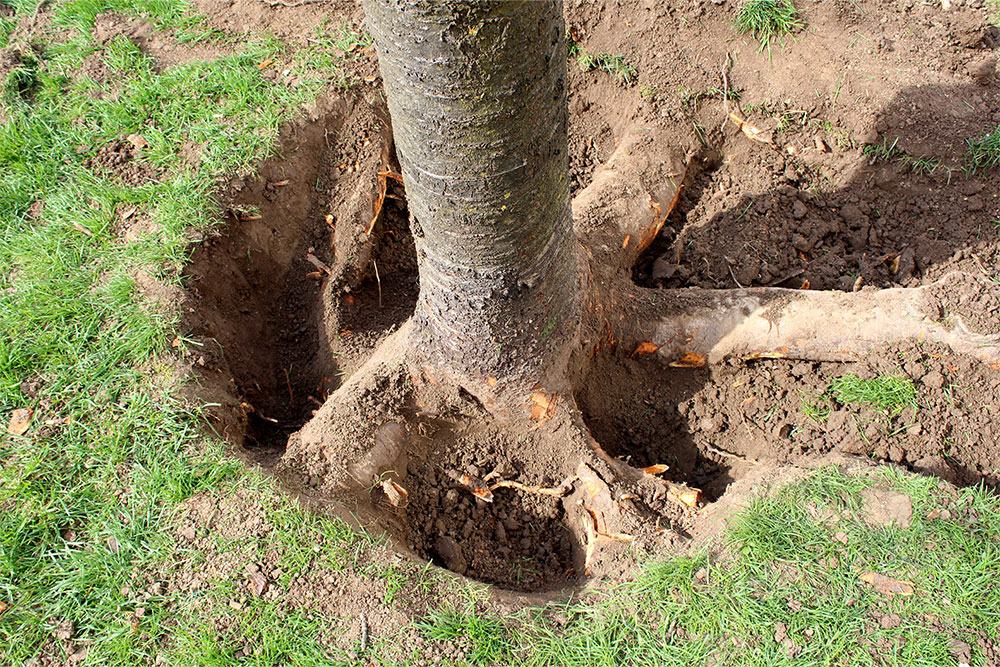A Guide To Cutting Tree Roots Without Killing Trees

Cutting tree roots without killing trees is a delicate process that demands care and understanding. Tree roots are vital for a tree’s health and stability, supplying it with the water, nutrients, and support it needs to thrive.
This guide maintains safe methods for cutting tree roots without harming the overall health or structure of the tree.
The Importance of Tree Roots
Tree roots are the foundation of the tree, serving both structural and nutritional purposes. They draw in water, nutrients, and oxygen from the soil–all important for the tree’s growth. Additionally, the roots anchor the tree to the ground. This prevents it from toppling in adverse weather.
Roots are categorized into two main types–feeder roots and perennial roots.
Feeder roots are smaller and responsible for absorbing water and nutrients. Perennial roots are larger and store key elements. This makes sure the tree remains anchored and receives nourishment.
These roots are important for the tree’s health. This means any disruption to the root system can negatively impact the tree’s well-being.
When is Cutting Tree Roots Necessary?
Cutting tree roots should only be done when absolutely required. If roots cause damage to utilities, sidewalks, or driveways, removal may be necessary.
However, cutting roots too close to the tree can weaken it, as those roots give vital support and store water. When cutting tree roots, it is important to follow a few key guidelines to minimize the risks.
First, avoid cutting roots that are larger than 2 inches in diameter. Large roots play a significant role in the tree’s health. Removing them may destabilize the tree or make it more vulnerable to pests and disease.
Additionally, roots should be cut at least three times the trunk’s diameter from the tree.
Safe Methods for Cutting Tree Roots Without Killing the Tree
Cutting tree roots requires more than just the right tools; it demands expertise and caution. Professional arborists follow specific methods to manage root removal safely.
For best results, consider hiring a professional vegetation management to handle this task. They understand how to maintain the tree’s balance and health.
Examine the Root System First
Before cutting begins, it is necessary to carefully inspect the root system. Gently clear the soil around the visible roots, or wash the soil away with water or a pressure washer.
This will allow you to determine which roots are problematic and which are necessary for the tree’s overall health.
Cutting Visible Surface Roots
Surface roots can be trimmed with tools such as a shovel or pruning saw. It is important to make clean cuts to prevent introducing pests or diseases. Once the roots are cut, cover the area with soil and compost to avoid further damage and encourage healthy regrowth.
Balance the Cutting
When removing roots, avoid cutting from just one side of the tree. Removing roots from a single side can upset the tree’s balance, which may result in instability. It is best to evenly distribute the cutting around the root system. This helps maintain symmetry to prevent harm to the tree.
Removing Large Roots
For larger roots that are damaging infrastructure like pipes, sidewalks, or driveways, it is important to dig deep enough to remove the root without harming surrounding roots. These larger roots often form tangled masses, which can make removal difficult.
In such cases, it is advisable to work with plumbers or arborists to make sure that roots are safely removed without compromising the tree’s health.
Post-Cutting Care
After cutting tree roots, it is important to give the tree proper care. Roots play a significant role in maintaining hydration and stability. That’s why removing too many can stress the tree.
Be sure to water the tree deeply after cutting to help it recover. Applying mulch around the base can also help retain moisture.
When to Call a Professional
If you are unsure about cutting tree roots on your own, it is a good idea to call in professionals. Arborists have the expertise to assess if root cutting is necessary and how to do it without compromising the tree’s health.
Consulting with experts helps you make sure that your tree remains healthy while addressing any root-related concerns.
How Coleman Environmental Engineering, LLC Can Help
Coleman Environmental Engineering, LLC specializes in vegetation management and environmental challenges. If you are dealing with problematic tree roots on your property, our team of experts can offer guidance and solutions to address your concerns.
We can help manage vegetation while confirming that your trees remain healthy. See our environmental engineering projects.
Reach out to us today for a tailored solution to your vegetation and environmental needs.
